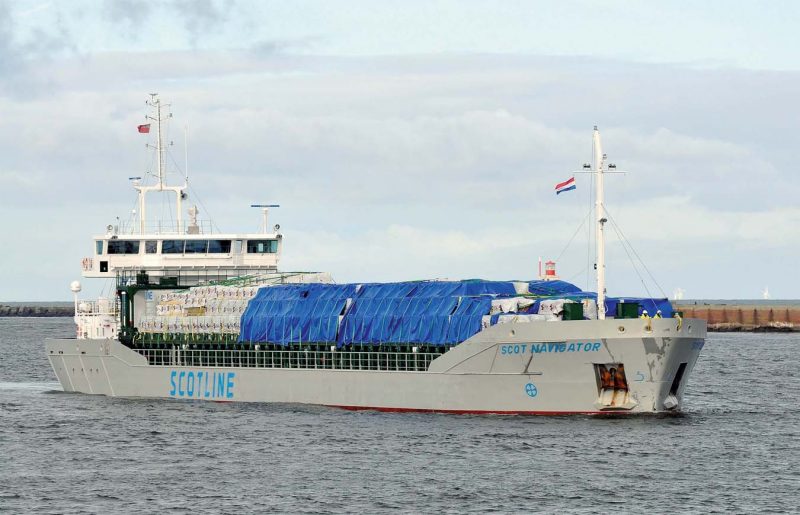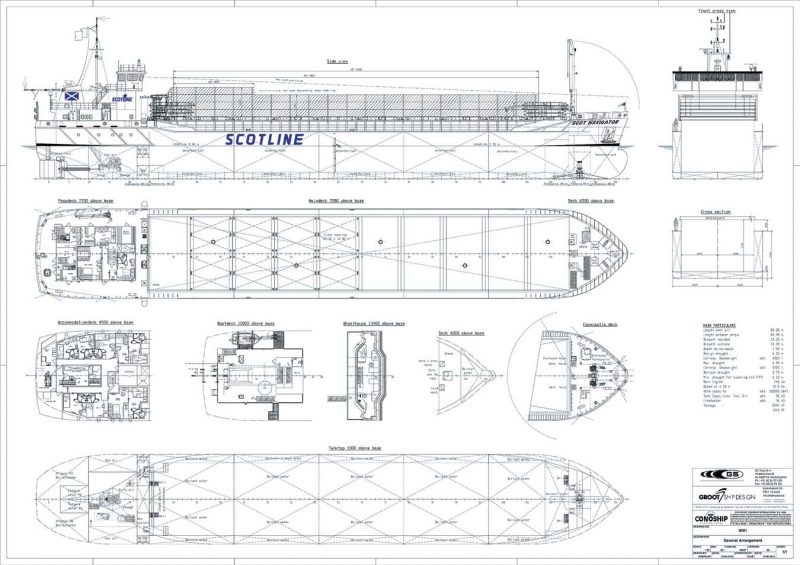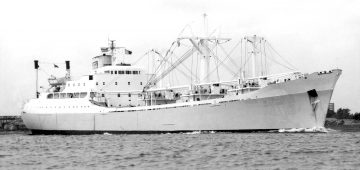
Scotline is a steadily advancing U.K based shipping company that can trace its roots back to humble beginnings in 1979. The company carried its first cargo that same year under the Scotline trading name and will celebrate its 40th anniversary in 2019. The first shipment was logs between Inverness and Bremen in Germany which became a regular route, before changing to Inverness-Varberg. In 1981 the company chartered its first vessel and set up the Scotline liner service, transporting sawn timber from Varberg to Inverness as a joint venture with Scotlog Sales. In the present day the liner service has established trade routes between Denmark, Germany, Ireland, Norway, Sweden, the Baltic States and the U.K. The initial service employed charter vessels until 1994 when Scotline Marine Holdings Ltd., a close business partner, purchased its first vessel, the Hohebank, which was time chartered by Scotline. The original operation at Inverness was expanded to additional sites at Whitstable in Kent and Goole in Yorkshire, before moving to Gunness in Yorkshire and Rochester in Kent during 1994. The 10 acre site at Rochester, on the banks of the River Medway, is owned by Scotline Terminal (Medway) Ltd. and was much larger than the facility used at Whitstable. The site was developed to include office facilities, 2 large warehouses, secure storage for equipment and a base for an engineering team to meet the requirements of the ships and terminals. By 2010 the space at the Rochester site had been completely exhausted and more was required. A second terminal was sought and acquired in January 2011 by Scotline Terminal (Transit) Ltd., adding a further 14 acres to the storage space available to Scotline in Rochester. The company’s head office was originally based in Holborn, London, before moving to Romford in Greater London where it still is today. On 1st February 2018 Scotline Ltd. announced the signing of a contract with Royal Bodewes Group BV in Holland to build one 4,785dwt Bodewes Trader design ship with the option of a second sister vessel. The ship, to be named Scot Carrier, will have a length of 89.98m, a beam of 15.20m and a maximum draught of 5.68m. She will be powered by a MAK engine, will be sailing under the U.K Flag and classed under Lloyds Register. The hull is expected to be launched in September 2018 and Scotline expects the ship to be delivered in November 2018. The Scot Carrier will be fully container fitted, with Swedish ice class 1B and will be built to comply with all the latest legislation including provisions to be ready for the new ballast water treatment system regulations. The Scot Carrier will join Scotline’s fleet of 8 owned vessels and follows on from the delivery of the 2,571gt Scot Navigator in 2017. The Scot Carrier is being built by the same yard and will be similar to the 3,183gt/2007 built Scot Leader. At the time of writing, Scotline also had four vessels on charter (see fleet list).
Growing the Fleet
The Scotline owned-fleet had previously grown further in 2017 with the addition of the vessel that is the subject of this newbuild feature. The ship took the form of a derivative of the Sea-River Liner 3700 developed by Groot Ship Design in co-operation with GS Yard and Dutch shortsea operator Wijnne Barends. The order for the economical and financially attractive Eco Freighter 3700 was placed on 16th December 2016 at the GS Yard in The Netherlands. This newbuild was a direct result of experience operating a sister vessel, the chartered 2,544gt/2015 built Lady Ariane from Dutch ship owner Wijnne Barends. Indeed, the Eco Freighter 3700 made its debut on the maritime scene in 2011 when the first of Wijnne Barends’ 11 Lady-A series of vessels was delivered. Scotline were said to be impressed with the Lady Ariane’s performance and the favourable ratio of cargo capacity versus fuel economy. Existing tonnage of the same calibre was not available which prompted the decision to order this newbuild. The new Scotline ship took the identity of Hull No. 169 and was constructed by GS Yard B.V in Waterhuizen, The Netherlands. This shipyard, an operating company of Hogau B.V, primarily constructs assorted vessel types for inland waterways and opened for business in 2007 on the former van Diepen Shipyard site in Groningen. The range of products evolved to include ship designs that can serve both inland and coastal waters. The first quartet of this multipurpose series of ships was built for Wijnne Barends. The yard has also constructed the hulls of two river cruise vessels built for De Gerlien van Tiem and they now trade on the River Rhine. The shipyard has a unique longitudinal slipway, making it possible to launch ships with a large tonnage with ease. The Naval Architect for this ship type, Groot Ship Design (GSD), is a design and engineering company based in Leek, The Netherlands. GSD has references in projects executed all over the world and a lengthy portfolio of ship designs including the Groot Cross-Bow, the EContFlex 1000/1200 and the SuperGreen 8500/10000. Assigned the name Scot Navigator, the newbuild was launched in Waterhuizen as the tenth vessel in Scotline’s fleet on 22nd February 2017.


Eco-Liner
The GS Eco Freighter 3700 design is a relatively green ship, built for longevity and economy. The Scot Navigator has an overall length of 88m, a beam of 13.35m and a maximum draught of 4.90m. The gross tonnage is 2,571gt, the deadweight is 3,732dwt, the net tonnage is 1,216t and the air draught in ballast is 27.8m. Unlike the Sea-River Liner 3700 design, the Eco Freighter 3700 has an enlarged superstructure with a fixed wheelhouse. A hydraulic column-mounted wheelhouse would only be necessary for lowering under bridges so as to access inland waterways. However, as the Eco Freighter is built for sea-going work, the design includes a fixed navigation bridge that is slightly higher than the maximum height of the adjustable wheelhouse on the previous Sea River Liner 3700 vessels. This general height increase also permits additional accommodation above the main deck, enhanced visibility from the bridge over the deck cargo and thus allows the loading of additional deck cargo. The forward area of the wheelhouse contains the navigation console, port side forward is home to the chart table, the radio desk is located starboard side aft and the bridge wings are enclosed and each equipped with a small control desk. By the nature of the ship type, all superstructure is located at the stern with the Accommodation Deck being the lowest of the four levels and 4.90m above the base line. Located here is the Captain’s dayroom, bedroom and bathroom (starboard side, forward), the Officer’s dayroom, cabin with bathroom (port side forward), five single-berth en-suite crew cabins (3 to port/2 to starboard) plus a changing room, an engine room workshop/store, the main switchboard room, the steering gear room and storage spaces. The accommodation is set at the standards for a ship below the 3,000gt threshold and facilitates a modern, comfortable environment for a crew of eight to eleven persons. All cabins are air-conditioned. Above the accommodation level is the Poopdeck (7.7m above the base line) that features on the starboard side a spare twin-berth cabin, the mess/day room and the air-conditioning/fan room. On the port side is a deck store, the galley, a provision store, SOS locker and the emergency generator room. Between this level at the bridge is the Boat Deck, 10.3m above the base line. There is no accommodation on this deck, just the funnel, a davit launched crew/rescue boat (the ship’s size and manning level does not require the fitting of a stern-mounted free fall lifeboat, thus saving deck space), stairway access to the wheelhouse plus the main mast. The latter is hinged to provide maximum overhead clearance if required.
The Eco Freighter 3700 class of ship is characterised by a hull form optimised for coastal and short-sea operation and a main engine power of only 749 kW. Combined with a 3,700gt cargo capacity, this provides an exceptionally low fuel consumption of less than three tonnes (3,500 litres) per day at a laden speed of 10 knot. The versatility of the design is an asset to Scotline’s operations, with the timber-fitted capacity of 5,500m3 in the Scot Navigator especially significant to the company’s Baltic trade. Scotline handles a large proportion of all softwood shipped to the United Kingdom and the Scot Navigator’s employment sees her carrying sawn timber for around 70% of the time, mixed with other less frequent cargoes such as wood pulp or project cargo. Owing to her design and commercial activity, the ship’s operating area is limited to the Baltic Sea, Scandinavia and the United Kingdom.
The Scot Navigator has a double hull (1 metre between the two skins), featuring one large, box-shaped hold, with a capacity of 5,154 cubic metres (182,000cu.ft.). The hold is 62.30m long, 10.80m wide and 7.73m deep, and features main deck hatch covers of equal sizes to provide the maximum clear opening. The hatch covers are 30cm thick, the hold area rises 1.65m above Boat Deck level and the hull depth from base line to Boat Deck is 7.5m. When the 10 pontoon-type hatch covers are closed, the main deck is flush between the forward bulkhead of the superstructure and forecastle deck. The covers are fitted with ample lashing points and fittings to accommodate 16 TEU (Twenty-foot Equivalent Unit), or 8 FEU (Forty-foot Equivalent Unit) containers. The covers can be removed and stowed in two stacks aft and forward of the hold, just ahead of the superstructure, and aft of the forecastle deck. This is done using a small gantry hoist that runs along a coaming rail on either side of the hatchway. The gantry is stowed in front of the superstructure when not in use. The hatch covers and gantry crane are supplied by Coops & Nieborg. Two movable bulkheads are available that can be positioned vertically in the hold to accommodate a cargo of grain or to divide a mixture of dry cargoes thus enhancing versatility. The hold is suitable for all general dry bulk or project cargo, but is particularly suitable for bales (wood pulp). When not required, the bulkhead panels are stored vertically against the aft wall of the hold. Over height project cargoes can be shipped with the hold open, subject to them not obstructing the view from the wheelhouse of course. Hold ventilation is achieved via provisions made at either end to provide a through flow of air. To further enhance the stability and trim of the ship at any load state, a total of 24 ballast tanks are situated in the sides and bottom of the double hull. These can also be used as passive anti-heel tanks. The hull profile is also virtually unaltered between fully laden at the 4.90m load line and sailing in ballast.
The Scot Navigator is powered by a 746kW Caterpillar 3508C marine diesel engine and this drives a nozzled ProMarin 2.31m diameter fixed pitch propeller featuring four high-skew blades via a ProMarin shaftline and a Reintjes WAF 572L reduction gearbox with a ratio of 7.47 : 1. The machinery spaces are located aft at Tank Top level. Manoeuvrability is provided by a Barke high-lift flap rudder and a 265kW/1,800rpm Veth-Jet 4-K-1000V bow thruster. The auxiliary equipment consists of one Scania 265kWe/60Hz generator set, a Caterpillar 119kWe/50Hz back-up generator set and the emergency power supply is provided by a Caterpillar 52kWe generator set. The machinery areas and cargo hold are protected by a MiniMax CO2 fire extinguishing system. To comply with present and future legislation, the engine room is equipped with a heat recovery system. This means that the cooling water from the engines passes through heat exchangers and this then generates heating for the accommodation. Efficient LED lighting is also fitted throughout the ship plus an extensive ballast water treatment system is installed.
Career Beginnings
A little over four months after launch the Scot Navigator ship departed from Delfzijl in The Netherlands in mid-June 2017 for her sea trials. The vessel was handed over to her owners, Scotline Marine Holdings, on 21st June 2017 and she then sailed to Varberg to load her first shipment of sawn timber destined for Scotline’s Terminal in Rochester on the River Medway. Upon arrival in Kent she was unloaded and prepared for her christening that took place on 7th July. That occasion consisted of a traditional ceremony performed by the ship’s godmother, Glenda, followed by a chance for the guests to inspect the vessel. The Scot Navigator is currently maintaining the liner service schedule from the Swedish west coast port of Varberg to Gunness, on the River Trent in eastern England. The round trip includes other UK loading points for the return eastbound voyage to Varberg. Located on the Kattegat, Varberg is Sweden’s leading export point for sawn timber and other forestry goods, and also receives pulp logs from Scotland shipped in Scotline vessels.





Comments
Sorry, comments are closed for this item